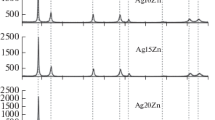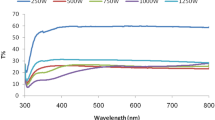Abstract
The anodic formation of Ag(I) oxide nanofilms on polycrystalline silver and Ag–Au alloys as well as on low-index single crystals of silver in 0.1 М KOH was examined. By the methods of photocurrent i ph and photopotential E ph measurements, the n-type conductivity of Ag2O film was established. Since the film (6–120 nm) is thinner than the space charge region, the dependence of photocurrent and photopotential appears on the film thickness L: i ph ~L and E ph ~L 2. The transition from polycrystalline silver to single crystals as well as the addition of a small amount of gold (X Au ≤ 4 at.%) into the silver lattice decreases the degree of deviation from the stoichiometric composition Ag2O. The parameters of Ag2O film (optical absorption coefficient α, donor defects concentration N D, space charge region W, and Debye’s length of screening L D) depend on the index of a crystal face of silver, volume concentration of gold X Au in the alloy, and film-formation potential E. At Е = 0.52 V, the sequences of variation of these parameters correlate with the reticular density sequence. The growth of the potential disturbs these sequences. The band gap in Ag2O formed on Agpoly, Aghkl, and Ag–Au is 2.32, 2.23, and 2.19 eV. Flat band potential in Ag(I) oxide, formed on Agpoly in 0.5 M KOH is 0.37 V. The appearance of the clear dependence between the state of the oxide/metal interface and the structure-sensitive parameters of semiconductor Ag(I) oxide phase allows considering the anodic formation of Ag2O on Ag as a result of the primary direct electrochemical reaction, not of the precipitation from the near-electrode layer.












Similar content being viewed by others
Notes
The numerical analysis shows that in thin films with a low level of light absorption (αL D < < 1), PP and PC values are negligibly small.
In a special set of experiments, the dependence of the capacity of Agpoly/0.5 M KOH boundary on the potential was obtained. The extrapolation in the coordinates of Mott–Schottky gives the value of flat band potential for Ag2O E fb = 0.37 V in accordance with [42], where E fb = 0.33 V
The problem of i ph decay in Ag(I) oxide on Aghkl after the film thickness achieves 50 nm needs further investigation in detail.
Note that the accuracy of determination of band gap in Ag2O oxide ± 0.1 eV is low enough to draw conclusions on the influence of the crystal face and alloy composition on E bg.
References
Hampson NA, Lee JB, Morley JR (1971) Electrochim Acta 16:637
Clarke TG, Hampson NA, Lee JB, Morley JR, Scanlon B (1969) Ber Buns Phys Chem 73:279
Becerra JG, Salvarezza RC, Arvia AJ (1990) Electrochim Acta 35:595
Alonso C, Salvarezza RC, Vara JM, Arvia AJ (1990) Electrochim Acta 35:489
Ambrose J, Barradas RG (1974) ElectrochimActa 19:781
Teijelo ML, Vilche JR, Arvia AJ (1984) J Electroanal Chem 162:207
Tilak BV, Perkins RS, Kozlovska HA, Conway BE (1972) Electrochim Acta 17:1447
Vidovich GL, Leikis DI, Kabanov BN (1962) Doklady Akademii Nauk SSSR 142:109
Droog JMM (1980) J Electroanal Chem 115:225
Doubova LM, Daolio S, Pagura C, De Battisti A, Trasatti S (2002) Russian J Electrochem 38:20
Savinova ER (2006) Razmernye i strukturnye effekty v elektrokatalize. Dissertation, Novosibirsk, Russia
Savinova E, Zemlyanov D, Pettinger B, Scheybal A, Schlogl R, Doblhofer K (2000) Electrochim Acta 46:175
Nechaev IV, Vvedenskii AV (2008) Sorbtsionnye I khromatograficheskiye protsessy 8:753
Nechaev IV, Vvedenskii AV (2009) Prot Met Phys Chem Surf 45:137
Marshakov IK, Vvedenskii AV, Kondrashin VY, Bokov GA (1988) Anodnoye Rastvoreniye i Selektivnaya Korroziya Splavov. VSU, Voronezh
Pickering HW (1968) J Electrochem Soc 115:143
Kaiser H. (1987) Chem Industries, Corrosion Mechanism. New York, Basel, 28: 85
Kaesche H (1979) Die Korrosion der Metalle. Springer Verlag, Berlin, Heidelberg, New York
Kuznetsova ТА, Flegel’ EV, Vvedenskii AV (2002) Prot Met 38:333
Kudryashov DA (2008) Anodnoye formirovaniye i svoistva nanoplyonki oksida Ag(I) na poli-, monokristallakh serebra i Ag, Au-splavakh. Dissertation, Voronezh, Russia
Vvedenskii А, Grushevskaya S, Kudryashov D, Kuznetsova T (2007) Corros Sci 49:4523
Forty AI, Rowlands G (1981) Phyl Mag 43A:171
Poate IM (1980) Gold Bull 14:2
Roldugin VI (2008) Fizikokhimiya poverkhnosti. Intellect, Moscow
Kapusta S, Hackerman N (1980) Electrochim Acta 25:1001
McAleer JF, Peter LM (1980) Farad Discuss Chem Soc 70:67
Collisi U, Strehblow HH (1990) J Electroanal Chem 284:85
Bard AJ, Stratmann M, Licht S (eds) (2002) Encyclopedia of electrochemistry. V.6: Semiconductor electrodes and photoelectrochemistry. Wiley-VCH, Weinheim
Zoski CG (ed) (2007) Handbook of electrochemistry. Elsevier, New Mexico State University
Pleskov YV, Gurevich YY (1986) Semiconductor photoelectrochemistry. Consultant Bureau, New York
Oshe EK, Rozenfel'd IL (1978) Itogi nauki I tekhniki. VINITI. Korroziya i zaschita ot korrozii: 111
Finklea HO (ed) (1988) Semiconductor electrodes. Elsevier, New York
Kudryashov DA, Grushevskaya SN, Vvedenskii AV (2007) Kondensirovannye sredy I mezhfaznye granitsy 9:53
Kudryashov DA, Grushevskaya SN, Vvedenskii АV (2007) Prot Met Phys Chem Surf 43:591
Vvedenskii A, Grushevskaya S, Kudryashov D, Ganzha S (2008) Surf Interface Anal 40:636
Luck’yanchilov AN, Grushevskaya SN, Kudryashov DA, Vvedenskii AV (2006) The environment for the photopotential measurement, Patent no. 55988 RF. Bulletin "Invitations. Useful models" 24: 3
Vvedenskii AV, Grushevskaya SN, Kudryashov DA, Luck’yanchilov AN (2007) The environment for the photocurrent measurement, Patent no. 66052 RF. Bulletin "Invitations. Useful models" 24: 3
Scheblykina GE, Bobrinskaya EV, Vvedenskii AV (1998) Prot Met 34:6
Kozaderov OA, Vvedenskii AV (2005) Prot Met 41:211
Wilson RH (1977) J Appl Phys 48:4292
Sutter EMM, Millet B, Fiaud C, Lincolt D (1995) J Electroanal Chem 386:101
Jiang ZY, Huang SY, Qian B (1994) Electrochim Acta 16:2465
Chatterjee K, Banerjee S, Chakravorty D (2002) Phys Rev B 66:854211
Kudryashov DA, Grushevskaya SN, Vvedenskii AV (2008) Prot Met Phys Chem Surf 44:301
Acknowledgements
We are grateful to Professor Leonid Kazanskiy (The Institute of Physical Chemistry and Electrochemistry of Russian Academy of Science) for the assistance in the XPS investigations.
This work is supported by Russian Foundation of Basic Research (project 09-03-00554-a).
Author information
Authors and Affiliations
Corresponding author
Rights and permissions
About this article
Cite this article
Vvedenskii, A., Grushevskaya, S., Kudryashov, D. et al. The influence of the conditions of the anodic formation and the thickness of Ag(I) oxide nanofilm on its semiconductor properties. J Solid State Electrochem 14, 1401–1413 (2010). https://doi.org/10.1007/s10008-009-0952-9
Received:
Revised:
Accepted:
Published:
Issue Date:
DOI: https://doi.org/10.1007/s10008-009-0952-9




